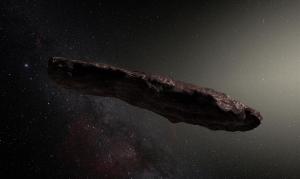Blog
Interstellar Asteroid Might Be A Comet
5 July 2018
 ESO/M. Kornmesser
ESO/M. KornmesserBack in 2017 an unusual object was discovered in our solar system. Given the name Oumuamua, it had a peculiar orbit. One tilted high away from the planetary orbits. With more observations, we found it’s motion was unusually fast. Too fast to remain in our solar system. Oumuamua had to have come from beyond the Sun, making a trip through the solar system before returning to the stars. Because of its size and distance, Oumuamua is a bit hard to study. We still aren’t sure about its composition, though it was thought to be an asteroid from another solar system. But new observations suggest it could be a comet.
We normally think of comets and asteroids as very different things. Comets are icy bodies that create gassy and dusty tails when they pass near the Sun, while asteroids are dry rocky bodies. But the two types of objects are far more similar. Asteroids can have dusty tails, and they can also have significant quantities of ice. Whether an object is an asteroid or a comet has much to do with how it formed, and its evolutionary history. In our solar system, this often relates to the size and shape of their orbits. Comets tend to have more elliptical orbits, while asteroids tend to have circular ones. That is, unless their orbit is gravitationally disrupted.
The original orbit of Oumuamua was clearly disrupted by a large planet, tossing the body out of its original star system. So we would need to look at its chemical composition, which we don’t have much data on. But we do have really good data on its orbital motion, and we’ve recently noticed it’s leaving our solar system1 a bit faster than expected.
The motion of any body in the solar system is governed by the laws of gravity. Because of this, after several measurements we can calculate the full orbit of a body gravitationally, something known as its ephemeris. If gravity is the only thing acting on a body, then its ephemeris should be pretty accurate. But Oumuamua’s is a bit off. It’s motion is faster than predicted, and that means something else must be pushing on it. Before you get excited about aliens, the push probably comes from outgassing, which is where water or other volitiles on the surface are vaporized by sunlight. When the vapor pushes off from the surface, it gives Oumuamua a little push, making it speed away from the Sun a bit faster.
Of course, outgassing is usually seen on comets, not asteroids. So these new results suggest Oumuamua is a comet rather than an asteroid.
Marco Micheli, et al. “Non-gravitational acceleration in the trajectory of 1I/2017 U1 (‘Oumuamua)” Nature DOI: 10.1038/s41586-018-0254-4 (2018) ↩︎